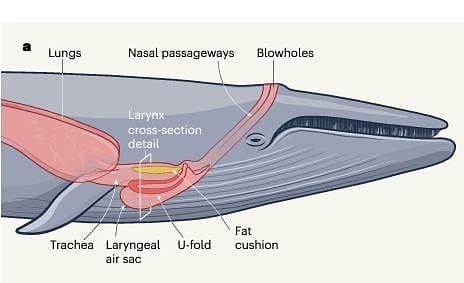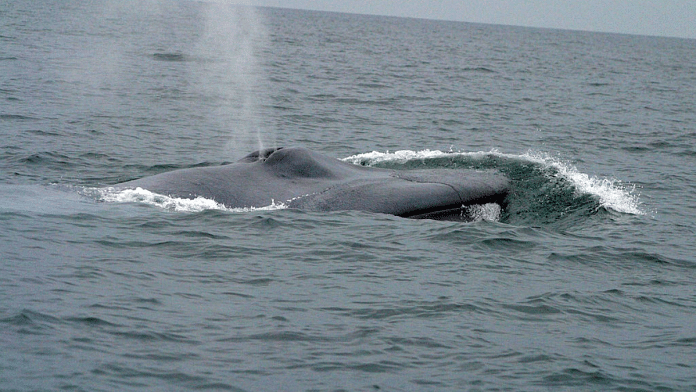Bengaluru: A new study gives an insight into the mysterious ‘whale song’ — the low-frequency vocalisations by the world’s largest mammals that have fascinated marine biologists for years. According to this study by European and American researchers, a specialised larynx (voice box) helps whales produce a sound that’s capable of travelling large distances.
The peer-reviewed study, which was published in Nature Wednesday, also says that the structure of the larynx also imposes restrictions on whale larynges — they are unable to produce higher frequency sounds, which could travel even farther.
Pertinently, the authors also found that the range of vocalisations produced by vocal whales falls within 30-300Hz — the range of noise produced by shipping vessels. This means that communication between vocalising whales would be gravely affected by human activity, and whales do not have the physical vocal ability to exceed this frequency range of sounds, the authors say.
The study gives greater insight into the world of whale vocalisation. Whales are known to use a variety of sounds, including moans, clicks, whistles, and pulses of sound.
While whales like humpback whales, minke whales and blue whales sing underwater, most others are capable of at least making moaning sounds.
Also Read: This ancient whale from Peru may be a new contender for most massive animal ever on Earth
Baleen whale throats
Whales that produce vocalisation are typically baleen whales. Born without teeth, these whales instead have filter-feeding plates — called baleen — in their mouths.
Baleen whales, which include gray whales, bowhead whales, humpback whales, and the largest mammal on earth, the blue whale, feed using a technique called gulp feeding. In this, the whale opens its mouth to take in a mouthful of water along with its prey, then uses the baleen apparatus, located along the sides of the mouth, to filter out the water before swallowing its prey.
Until now, it was thought that these whales produced sound by pushing air between folded tissues in their throat, leading them to vibrate, like a whistle. However, the new study reveals a previously unknown airflow pathway in the larynx of baleen whales.
In the study, scientists studied the physiology and the larynges of three beached individual whales — a sei whale, a common minke, and a humpback whale. They studied and scanned the structure of these animals’ throats and larynges and modelled it to reconstruct the mechanism of vocalisation.
In all three, they found that sound is produced by aerodynamic vibrations in specific parts of the voice box of baleen whales that are not present in toothed whales. These special structures, the researchers say, allow for the production of sound as well as the recycling of air, which helps prevent the whale from inhaling water accidentally.
The pathway that the air took showed that the whale’s larynx squeezes air between a fold of tissue and a patch of fatty material above it. This leads to the path of fat to vibrate, thus generating sound. This is a U-shaped structure — the U-fold carries air through it. Both the arms of the U flatten out at the top due to the fatty layer resting on them.

This throat structure has allowed baleen whales to adapt their larynx to create vocalisations within a small, low-frequency range of roughly 3-300 Hz, the study says. On the other hand, toothed whales evolved a nasal vocal organ that produces sounds like grunts from the nose instead of the throat.
The study also found that whale sounds travel a maximum depth of 100 m and cannot exceed 300 Hz in frequency.
Anatomical studies have now established that the specific U-shaped part of the whale’s larynx, which carries vocal folds and cartilage that support them, thus producing sound, makes them the equivalent of land mammals’ vocal cords.
Whale song
Beyond vocalisations, singing whales are also able to group their sounds to produce a song. These songs have a unique structure and are complex enough to be compared to human compositions. (Humpback whales are often called the composers of the sea.)
A song is made up of a base unit sound called a note, which lasts a few seconds. A group of four or six notes is called a sub-phrase, lasting about ten seconds. Two sub-phrases make up a phrase, and the whales repeat a phrase for 3-4 minutes. This is known as a theme. A collection of themes is called a song.
Humpback songs can last up to half an hour and will be repeated for hours or days.
Whale songs have been recorded throughout history, especially during the early days of sailing, when sailors documented sounds from underwater that would cause the ship to reverberate. The invention of hydrophones, long and dangly microphones for underwater use, enabled humans to record and properly document whale songs.
Whale songs are thought to be the most complex sound structure produced in the animal kingdom beyond humans. With the new findings, scientists have now understood the instrument within that produces these magical sounds.
Questions remain
Whales are evolutionarily descended from land mammals, as large land-roaming whales went back into the waters 50 million years ago. The ones that remained on land evolved into hippos.
It is understood that the larger anatomical structure of the larynx was inherited by whales from their land mammal ancestors but the organ changed over millions of years. Compared to the vocal folds in land mammals, the whale U-fold is flipped over sideways.
Despite understanding the production of whale sound through modelling, the authors state that this cannot be confirmed unless studied on a live whale making a sound.
But because of their humongous size, this becomes hard to do in captivity, as marine animals like gigantic whales and sharks cannot survive in captivity with limited swimming range. Smaller marine mammals of the same family, like dolphins, can be studied, but their larynges vary from baleen whales and they use structures in their nose to produce sounds.
Additionally, recordings of whales have shown that a whale can produce two different sounds at different frequencies simultaneously despite having only a single vocal box. Some earlier studies have suggested that the sounds originate in two different locations.
The authors of the study performed experiments blowing air through the three larynges they studied from the whale carcasses. They found that the air vibrations occur on the soft tissue of the flattened arms of the U-fold on both sides, instead of only in the middle, above the curve of the U. This leads to sound generation on both sides of the U, effectively leading to two sources of sound production, speculate researchers in New York in an accompanying scientifically commentary.
Furthermore, the authors of the study also state that these U-folds were found opposite a fat cushion in all whale larynges, and thus could have been present in the ancestors of modern whales. However, the thickening of the arms of the U-fold is observed only in humpback and bowhead whales, indicating that it changed during evolution.
Thicker folds are more flappy and can function as vocal folds.
This suggests that whales either independently acquired a way to produce this fold-vocalisation method, or regained their ability to do so. Understanding this will require a detailed study of how land mammal’s larynges transfer air from the larynx to the mouth to convert it to sound. This, in turn, could help understand other completely random sounds that whales produce, such as gunshot sounds and ‘boing’ sounds, the academic commentary says.
Lastly, in humans and land mammals, sound is produced when the vocal folds vibrate. They then push air out in the form of pressure waves, which then propagate through the air as sound. How whales transfer their sounds from inside their body to the water column continues to remain a mystery.
The fact also remains that the limited range of whale frequencies and their overlap with shipping vessels threatens their safety and survivability.
“These laryngeal structures set insurmountable physiological limits to the frequency range and depth of their vocalizations, preventing them from escaping anthropogenic vessel noise and communicating at great depths, thereby greatly reducing their active communication range,” the authors say.
(Edited by Uttara Ramaswamy)
Also Read: Unsustainable logging, hunting — new report finds what’s driving a million species to extinction



